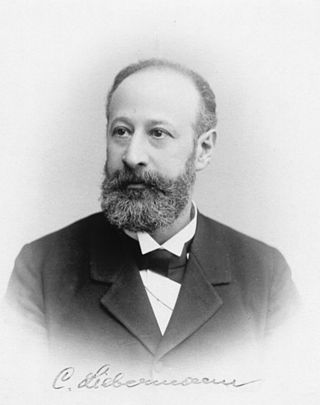Related Research Articles

Alizarin is an organic compound with formula C
14H
8O
4 that has been used throughout history as a red dye, principally for dyeing textile fabrics. Historically it was derived from the roots of plants of the madder genus. In 1869, it became the first natural dye to be produced synthetically.
The year 1781 in science and technology involved some significant events.
The year 1747 in science and technology involved some significant events.
The year 1780 in science and technology involved some significant events.
The year 1658 in science and technology involved some significant events.

1,2,4-Trihydroxyanthraquinone, commonly called purpurin, is an anthraquinone. It is a naturally occurring red/yellow dye. It is formally derived from 9,10-anthraquinone by replacement of three hydrogen atoms by hydroxyl (OH) groups.

Rose madder is a red paint made from the pigment madder lake, a traditional lake pigment extracted from the common madder plant Rubia tinctorum.

Pierre Jean Robiquet was a French chemist. He laid founding work in identifying amino acids, the fundamental building blocks of proteins. He did this through recognizing the first of them, asparagine, in 1806. He likewise laid founding work in the industry's adoption of industrial dyes, with the identification of alizarin in 1826, and in the emergence of modern medications, through the identification of codeine in 1832, an opiate alkaloid substance of widespread use with analgesic and antidiarrheal properties.

Carl Theodore Liebermann was a German chemist and student of Adolf von Baeyer.

Rubia tinctorum, the rose madder or common madder or dyer's madder, is a herbaceous perennial plant species belonging to the bedstraw and coffee family Rubiaceae.

Andrea Vaccà Berlinghieri was an Italian surgeon born in Montefoscoli, a village in the municipality of Palaia. His older brother, Leopoldo Vaccà Berlinghieri (1768–1809), was a noted Tuscan military figure. His father, Francesco Vacca Berlinghieri (1732-1812), was also a noted physician and writer of medical texts in Tuscany.
References
- ↑ Unverdorben, Otto (1826). "Ueber das Verhalten der organischen Körper in höheren Temperaturen" [On the behaviour of organic substances at high temperatures]. Annalen der Physik und Chemie. 8 (11): 397–410. Bibcode:1826AnP....84..397U. doi:10.1002/andp.18260841109.
- ↑ Robiquet, Pierre-Jean; Colin, Jean-Jacques (1826). "Sur un nouveau principe immédiat des vègétaux (l’alizarin) obtenu de la garance" [On a new substance from plants (alizarin) obtained from madder]. Journal de pharmacie et des sciences accessoires 2nd series, 12:407–412; Colin, Jean-Jacques; Robiquet, Pierre-Jean (1827). "Nouvelles recherches sur la matierè colorante de la garance" [New research into the coloring material of madder]. Annales de chimie et de physique 2nd series, 34:225–253.
- ↑ Rolt, L. T. C. (1958). Thomas Telford . London: Longmans, Green.
- ↑ X4,378 Gas Or Vapor Engine
- ↑ Hardenberg, Horst O. (1992). Samuel Morey and his atmospheric engine. SP-922. Warrendale, Pa.: Society of Automotive Engineers. ISBN 1-56091-240-5.
- ↑ Maurer, Leon. "The Unsolved Mystery of Samuel Morey". Archived from the original on 2013-11-03. Retrieved 2013-11-01.
- ↑ "The First Photograph". Harry Ransom Center, University of Texas at Austin. Archived from the original on 2009-12-27. Retrieved 2013-11-01.
- ↑ Reported as "Ovi Mammalium et Hominis genesi" to the Imperial Academy of Sciences in Saint Petersburg in 1827 (published at Leipzig).
- ↑ Petrunkevitch, Alexander (1920). "Russia's Contribution to Science". Transactions of the Connecticut Academy of Arts and Sciences. 23: 236.
- ↑ "Биография Бэр Карл Максимович". AllPersona.Ru. Archived from the original on 2008-03-19. Retrieved 2011-05-18.
- ↑ Meyer, J. N. (1826). Dissertatio inauguralis anatomico-medica de genere felium. Doctoral thesis, University of Vienna.
- ↑ "Copley Medal | British scientific award". Encyclopedia Britannica. Retrieved 22 July 2020.
- ↑ "Gegenbaur, Carl (1826-1903)". catalogue.bnf.fr (in French). Bibliothèque Nationale de France. Retrieved 6 February 2021.
- ↑ Corlieu, Auguste (1901). "Le docteur Dumangin de Château-Thierry et le cœur de Louis XVII". Annales de la Société historique et archéologique de Château-Thierry (in French): 103–107.
- ↑ "Tissot, Clément-Joseph (1747-1826)". catalogue.bnf.fr (in French). Bibliothèque Nationale de France. Retrieved 6 February 2021.
- ↑ "Laennec, René-Théophile-Hyacinthe (1781-1826)". catalogue.bnf.fr (in French). Bibliothèque Nationale de France. Retrieved 6 February 2021.
- ↑ Andrea Vaccà Berlinghieri at Who Named It?
- ↑ "Abel, Clarke (1789-1826)". catalogue.bnf.fr (in French). Bibliothèque Nationale de France. Retrieved 6 February 2021.